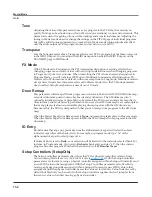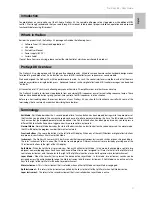
Master Mode
MAIN
11-9
In general, you should select a nonstandard intonation map when you’re playing simple
melodies (as opposed to chords) in a particular musical style. When you use intonation maps
based on pentatonic scales, you’ll normally play pentatonic scales to most accurately reproduce
those styles.
Editing Intonation Maps
To edit an intonation map or create a new map, select an existing map and press the Edit button
to bring up the EditIntonationMap screen
(see below.)
Intonation maps are based around a root
key, shown on the right of the top line of the screen. Use the
chan up/down
buttons to change the
root key (this is the same as changing the Int.Key parameter (see
Intonation Key (Int.Key)
below.)
Intonation Key is not saved with the intonation map.) Use the cursor to move between note steps,
each of which is labeled by its difference in keyboard steps from the root. Each step can be shifted
by ± 200 cents (100 cents=1 half-step.) Use the alpha wheel, alphanumeric pad, or plus/minus
buttons to enter the desired cent shift amount for each step.
Press
Delete
to delete the map from memory. Press
Rename
to rename the map and save.
Pressing
Save
gives you the option to save the map or rename and save. To create a new map,
edit an existing map and choose Rename when saving. Press
Exit
to return to Master page 2.
When exiting the editor, it will automatically give you the option to save the map if changes have
been made. For more detailed instructions on these functions, see
Saving and Naming
on page 5-3
.
Key Action Map
The Key Action Map determines the default way the PC3A responds to key action for specific
keyboard component models. Generally speaking, you will not want to alter the Key Action
Map. This parameter is included for the rare occasion when a PC3A has been setup at the factory
for a different keyboard component model than the one installed. A user may discover that they
need to change the Key Action Map when they have tried all of the Velocity Map settings and still
do not feel comfortable with the key response of their PC3A. Different maps result in different
responses from the PC3A for the same physical key action, and each map corresponds to a
different keyboard component model. If you have changed this parameter and want to change it
back to the default map for your PC3A, simply enter a value of 0 in the Key Action Map
parameter field.
Intonation Key (Int.Key)
This sets the tonic, or base note from which the currently selected intonation map calculates its
intervals. If you select
G
as the intonation key, for example, and the intonation map you select
tunes the minor 2nd down by 50 cents, then G
#
will be a quartertone flat relative to equal
intonation. If you change the intonation key to
D
, then D
#
will be a quartertone flat. If you use
nonstandard intonations, you’ll want to set Int.Key to the key you’re playing in. If the Intonation
parameter is set to
Equal
, changing Int.Key has no effect.
















































